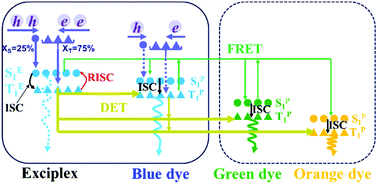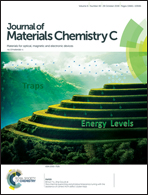Improvement of efficiency and its roll-off at high brightness in white organic light-emitting diodes by strategically managing triplet excitons in the emission layer†
Abstract
Although white organic light-emitting diodes (WOLEDs) have grown dramatically in solid-state lighting, realizing high efficiency and low efficiency roll-off simultaneously is still a prerequisite for practical applications. Here, high efficiency and low efficiency roll-off WOLEDs are presented by strategically managing triplet excitons in the emission layer. In our devices, the emission layer is constructed by strategically introducing non-doped ultrathin orange and green phosphorescent emitters in the blue phosphorescence-doped exciplex host. It can be seen that the triplet excitons within the emission layer are effectively regulated through such an engineering method. As a result, the resulting WOLED operates at a low turn-on voltage of ∼2.3 V due to well-matched energy alignment, and exhibits a maximum forward-viewing power efficiency (PE) and external quantum efficiency (EQE) of 95.3 lm W−1 and 22.8% which remain at 55.5 lm W−1 and 21.9% at 1000 cd m−2 without using light out-coupling techniques. Remarkably, at luminances of 5000 and 10 000 cd m−2, the EQEs are still as high as 20.4% and 18.9%, exhibiting extremely low efficiency roll-off. It is believed that the strategies of emission layer engineering are beneficial for the future development of high efficiency and low roll-off WOLEDs.



 Please wait while we load your content...
Please wait while we load your content...